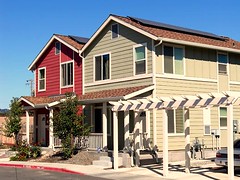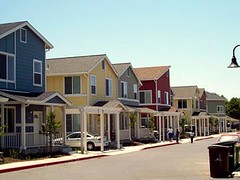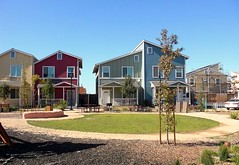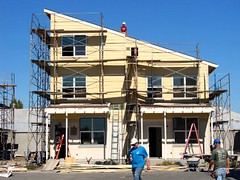Habitat partners with state, private sector to build affordable LEED-ND project in Oakland

Posted November 17, 2009 at 1:40PM
Habitat for Humanity's East Bay affiliate is retrofitting a brownfield into 54 affordable homes on two acres of land in Oakland, California. With excellent location, walkable density, great design, and green features, the Edes Avenue project is participating in the pilot program of LEED for Neighborhood Development, in which NRDC is a founding partner.
According to the project's website, the homes are located a half mile from another Habitat development of 40 houses on 105th Avenue, in the Sobrante Park Neighborhood of East Oakland. The buildings are two-story wood frame homes, with a total development cost of $7 million. The first six were built in two weeks in 2006 following a ground-breaking and "Builder's Blitz" by partners KB Homes and Pulte Homes. Eight additional units were framed from foundations to roofs in just four days during a 2007 Earth Day Build-A-Thon. Many of the homes will be dedicated on December 12th, when the keys will be handed over to the new homeowners. (The homeowners also participated in the project's construction.)
Habitat purchased the property in 2002 with assistance from the City of Oakland and the Center for Creative Land Recycling. The organization then partnered with the California Department of Toxic Substances Control (DTSC) to transform the property into a healthy neighborhood for deserving low-income families. The DTSC, which awarded Habitat a $425,000 low-interest loan to finance the brownfield investigation, worked closely with the organization to approve the subsequent cleanup plan. Roughly 300,000 cubic yards of contaminated soil had to be removed and replaced.
 The homes will have a number of green features. According to the website, they include:
The homes will have a number of green features. According to the website, they include:
- Solar power panels
- Passive solar design that eliminates the need for air conditioning
- Double-thick concrete foundation for thermal insulation
- Concrete made of 40 percent fly ash content, lending added durability and requiring less energy to manufacture
- Wall insulation made of recycled paper scraps
- 40 percent of wood used in construction certified by the Forest Stewardship Council
- Milgard fiberglass windows
- On-demand hot water heaters
- Compact fluorescent lighting
- No or low-VOC paints throughout
The solar panels were made possible by grants from Pacific Gas & Electric, which provided $15,000 per home. The combination of green design and on-site renewable energy is expected to reduce utility bills to around $9 per month for two-bedroom homes and less than $15 per month for three- and four-bedroom homes.  The grants for the solar panels came from PG&E's Solar Habitat Program, an ongoing partnership between the utility company and Habitat for Humanity.
The grants for the solar panels came from PG&E's Solar Habitat Program, an ongoing partnership between the utility company and Habitat for Humanity.
The project is registered under LEED-ND, and six homes are in the process of being certified also by the affordable housing program of LEED for Homes.
Writing in Inhabitat, Piper Kujac reports that the Edes Avenue project "was designed by famed neighborhood expert, architect Michael Pyatok, and has been in part carried out by Struthers Dias Architects." Kujac also notes that the Lowe's Corporation participated in the project through its Habitat's Women Build Program, through which 500 hours of building was facilitated by women who want to help our their communities and learn construction skills. More construction details and beautiful images of the project are posted on Inhabitat.



